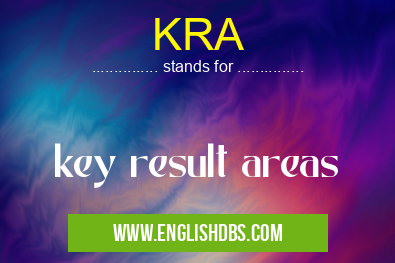What does KRA mean in UNCLASSIFIED
KRA stands for Key Result Areas. It is a performance measurement tool used to measure the success of individuals and teams in organizations. KRAs are created to track key results that are expected from employees, allowing management to identify areas where individuals or teams need improvement. The goal of KRA is to ensure that all goals or objectives set by the organization are achieved or exceeded.

KRA meaning in Unclassified in Miscellaneous
KRA mostly used in an acronym Unclassified in Category Miscellaneous that means key result areas
Shorthand: KRA,
Full Form: key result areas
For more information of "key result areas", see the section below.
Definition
KRA stands for Key Result Areas which refer to measurable outcomes that organizations seek from employees, teams, departments and divisions. These outcomes measure how successful an organization was in achieving its desired objectives and goals. KRAs typically include both quantitative (numerical) measures, such as a percentage increase in sales revenue, and qualitative measures, such as improving customer satisfaction levels by 10%.
Benefits
Having clear KRAs makes evaluation of individual and team performance easier while providing motivation and direction to those who contribute in achieving company goals. By measuring success with well-defined KRAs, management can easily pinpoint areas where improvements can be made along with their causes. Additionally, since the performance of senior leaders is often judged on their ability to reach KRA targets, having them defined increases accountability amongst upper level management and provides incentive for success.
Essential Questions and Answers on key result areas in "MISCELLANEOUS»UNFILED"
What is KRA?
KRA stands for Key Result Areas which are the focus areas for employee performance and contribution in a particular job role. The focused KPIs or objectives that employees need to accomplish and deliver within the given period of time are what defines KRA's.
How to identify relevant KRA?
Relevant KRAs can be identified by considering core duties, responsibilities and goals associated with that particular job role. There should also be a clear connection with organization's mission and objectives in order to ensure successful outcomes.
Why is it important to have clear KRAs?
Having clear KRAs are important for employee performance management as it sets expectations and provides clarity on employee's responsibility and accountability. Clear KRAs also serve as an accurate tool to measure employee performance against pre-set metrics.
What is the purpose of KRAs?
The main purpose of Key Result Areas is to encourage employees to think beyond their job roles and contribute towards the company's overall success. It helps them understand how their individual performance affects organizational goals and objectives.
Who all should be involved in defining KRAs?
Defining KRAs should involve stakeholders such as supervisors, managers, HR, top executives etc., to ensure that they align with organizational goals & objectives. They should also involve employees who would provide valuable insight into their specific job roles.
Is there any standard way of setting up KRA's?
Setting up KRAs can vary from one organization to another depending upon the different job roles & corresponding requirements; however, following best practices such as goal setting & time management will help define key result areas effectively irrespective of organization type.
What should be taken into consideration while creating KRA's?
While developing Key Result Areas certain parameters must be kept into consideration such as its measurable value, detailedness of objective, time frame for completion etc., This will help create more effective & realistic targets for employees.
How often should I review my KRAs?
Your Key Result Areas must be reviewed on regular basis mainly at year end or when there are changes in either job role or organization objectives/goals. This will ensure that your performances are being monitored against current industry standards.
Final Words:
Overall, having well-defined KRAs helps organizations reach greater heights by providing a common language for reporting results of efforts put into different initiatives within an organization while also promoting collaboration between different employee groups and creating an environment of openness where progress can be tracked effectively.
